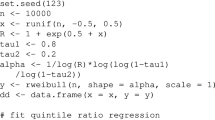Abstract
We discuss a practical and effective framework to estimate reference growth charts via regression quantiles. Inequality constraints are used to ensure both monotonicity and non-crossing of the estimated quantile curves and penalized splines are employed to model the nonlinear growth patterns with respect to age. A companion R package is presented and relevant code discussed to favour spreading and application of the proposed methods.


Similar content being viewed by others
References
Bollaerts K, Eilers PHC, Aerts M (2006) Quantile regression with monotonicity restrictions using \(P\)-splines and the \(L_1\)-norm. Stat Model 6:189–207
Bondell HD, Reich BJ, Wang H (2010) Non-crossing quantile regression curve estimation. Biometrika 97:825–838
Borghi E, de Onis M, Garza C, the WHO Multicentre Growth Reference Study Group (2006) Construction of the world health organization child growth standards: selection of methods for attained growth curves. Stat Med 25:247–265
Bosch RJ, Ye Y, Woodworth GG (1995) A convergent algorithm for quantile regression with smoothing splines. Comput Stat Data Anal 19:613–630
Cade BS, Noon BR (2003) A gentle introduction to quantile regression for ecologists. Front Ecol Environ 1:412–420
Cole TJ, Green P (1992) Smoothing reference centile curves: the LMS method and penalized likelihood. Stat Med 11:1305–1319
Dette H, Volgushev S (2008) Non-crossing non-parametric estimates of quantile curves. J R Stat Soc B 70:609–627
Duarte CM, Marbà N, Agawin N, Cebrian J, Enriquez S, Fortes MD, Gallegos ME, Merino M, Olesen B, Sand-Jensen K, Uri J, Vermaat J (1994) Reconstruction of seagrass dynamics:age determinations and associated tools for the seagrass ecologist. Mar Ecol Prog Ser 107:195–209, http://www.int-res.com/articles/meps/107/m107p195.pdf
He X (1997) Quantile curves without crossing. Am Stat 51:186–192
He X, Shi P (1998) Monotone B-spline smoothing. J Am Stat Assoc 93:643–649
Hedley AA, Ogden CL, Johnson CL, Carroll MD, Curtin LR, Flegal KM (2004) Prevalence of overweight and obesity among US children, adolescents, and adults, 1999–2002. J Am Med Assoc 291:2847–2850
Koenker R (2005) Quantile regression. Cambridge University Press, Cambridge
Koenker R (2011) quantreg: Quantile Regression. http://CRAN.R-project.org/package=quantreg, R package version 4.71
Koenker R, Ng P, Portnoy S (1994) Quantile smoothing splines. Biometrika 81:673–680
Liu J, Ji S, Ye J (2009) SLEP: sparse learning with efficient projections. Arizona State University, http://www.public.asu.edu/jye02/Software/SLEP
Meyer M, Woodroofe M (2000) On the degrees of freedom in shape-restricted regression. Ann Stat 28:1083–1104
Muggeo VMR (2003) Estimating regression models with unknown break-points. Stat Med 22:3055–3071
Muggeo VMR, Sciandra M, Augugliaro L (2012) Quantile regression via iterative least squares computations. J Stat Comput Simul 82:1557–1569
Ng PT (1996) An algorithm for quantile smoothing splines. Comput Stat Data Anal 22:99–118
R Development Core Team (2010) R: A language and environment for statistical computing. R Foundation for Statistical Computing, Vienna, Austria, http://www.R-project.org, ISBN 3-900051-07-0
Rigby RA, Stasinopoulos DM (2004) Smooth centile curves for skew and kurtotic data modelled using the box-cox power exponential distribution. Stat Med 23:3053–3076
Rigby RA, Stasinopoulos DM (2005) Generalized additive models for location, scale and shape (with discussion). Appl Stat 54:507–554
Tomasello A, Calvo S, Maida GD, Lovison G, Pirrotta M, Sciandra M (2007) Shoot age as a confounding factor on detecting the effect of human-induced disturbance on posidonia oceanica growth performance. J Exp Mar Biol Ecol 343(2):166–175. doi:10.1016/j.jembe.2006.11.017, http://www.sciencedirect.com/science/article/pii/S0022098107000330
Wei Y, Pere A, Koenker R, He X (2006) Quantile regression methods for reference growth charts. Stat Med 25:1369–1382
Yuan M (2006) GACV for quantile smoothing splines. Comput Stat Data Anal 50:813–829
Acknowledgments
The authors would like to thank the referee for his/her valuable comments.
Author information
Authors and Affiliations
Corresponding author
Additional information
Handling Editor: Ashis SenGupta.
Rights and permissions
About this article
Cite this article
Muggeo, V.M.R., Sciandra, M., Tomasello, A. et al. Estimating growth charts via nonparametric quantile regression: a practical framework with application in ecology. Environ Ecol Stat 20, 519–531 (2013). https://doi.org/10.1007/s10651-012-0232-1
Received:
Revised:
Published:
Issue Date:
DOI: https://doi.org/10.1007/s10651-012-0232-1




